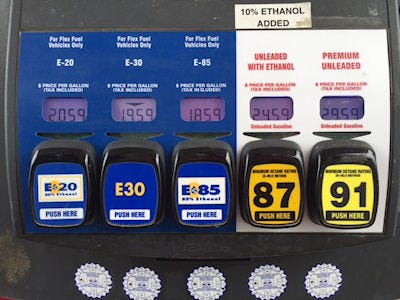USDA invests $100M for blender pumps
Uncertainty from avian flu and lower commodity prices leads USDA to attempt to double number of higher blender pumps.
May 29, 2015

In an effort to double the number of higher blend renewable fuel pumps and create more certainty for commodity producers, the U.S. Department of Agriculture announced an investment of up to $100 million in a Biofuels Infrastructure Partnership.
Specifically, USDA will administer competitive grants to match funding for state-led efforts to test and evaluate innovative and comprehensive approaches to market higher blends of renewable fuel, such as E15 and E85. States that are able to provide greater than a one-to-one ratio in funding will receive higher consideration.

Pictured is a flex pump which allows consumers to choose what blend they want to use.
Secretary of Agriculture Tom Vilsack said farmers are producing record amounts of feedstocks for biofuels, but a combination of factors, including lower commodity prices and reduced demand for feed as the poultry industry recovers from highly pathogenic avian influenza, are creating uncertainty for America's corn and soybean producers.
“With this partnership, USDA is helping to ensure the infrastructure is in place for consumers to access more renewable fuels, expand marketing opportunities for farmers, and grow America's rural economies," Vilsack said.
Higher blends of renewable fuel offer significant potential for increasing the use of renewable fuels in the U.S. gasoline pool, but currently, the typical gas pump can deliver fuel containing a maximum of 10 percent ethanol, limiting the amount of renewable energy consumers can use to fuel their cars. This new USDA partnership will help support the installation of fuel pumps capable of supplying higher blends of renewable fuel by partnering with states to fund innovative, public-private partnerships to test more comprehensive approaches to marketing such blends. This new investment seeks to double the number of fuel pumps capable of supplying higher blends of renewable fuel to consumers, such as E15 and E85.
The United States exported more than $2 billion dollars of ethanol last year, making the United States the world's largest exporter of ethanol. Additionally, the United States has become a market leader in the export of high-quality distiller's dried grains (DDG), a byproduct of ethanol production used as a high-protein feed for livestock and poultry. Other countries are investing in clean energy technologies because they realize the tremendous economic potential of these energy sources, and the United States must do the same to remain competitive. The projects funded by these competitive grants will expand markets for farmers and help them diversify their rural energy portfolios, support rural economic growth and the jobs that come with it, and ultimately give consumers more affordable options at the pump.
The Environmental Protection Agency released its Renewable Fuels Standard volumes Friday (see related story). A court mandates EPA release the yearly volume requirements by June 1. The 2014 requirements were first proposed in the fall of 2013 and have yet to be finalized.
You May Also Like


.png?width=300&auto=webp&quality=80&disable=upscale)
